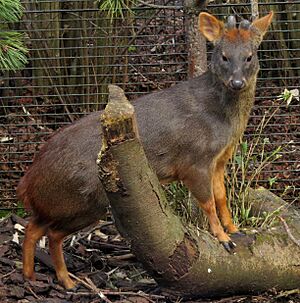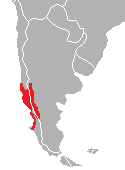Southern pudu facts for kids
Quick facts for kids Southern pudu |
|
|---|---|
 |
|
| Southern pudu (P. puda) | |
| Conservation status | |
| Scientific classification | |
| Genus: |
Pudu
|
| Species: |
puda
|
 |
|
| Geographic range of Pudu puda | |
| Synonyms | |
|
Capra puda Molina, 1782 |
|
The southern pudu (Pudu puda) is a very small deer. It lives in the forests of south-central Chile and nearby Argentina. People in the Mapudungun language call it püdü or püdu. In Spanish, it's called pudú.
This tiny deer is listed as "Near Threatened" by the IUCN Red List. This means it could become endangered if its situation does not improve.
What Does the Southern Pudu Look Like?
The southern pudu is the second smallest deer on Earth! It's a bit bigger than its cousin, the northern pudu. An adult southern pudu stands about 35 to 45 centimeters (14 to 18 inches) tall at the shoulder. It weighs between 6.4 and 13.4 kilograms (14 to 30 pounds).
The antlers of the male southern pudu are quite short. They grow to be about 5 to 9 centimeters (2 to 3.5 inches) long. These antlers curve backward a little, like those of a mountain goat. The pudu's fur is a dark chestnut-brown color. It often has a tuft of fur on its forehead that covers its antlers.
Where Does the Southern Pudu Live?
The southern pudu lives in forests. These can be old, untouched forests or areas where trees have been cut down. They especially like places with lots of dense plants growing close to the ground. However, they also enjoy open areas with rich plants to eat.
You can find them from sea level up to 1,700 meters (5,600 feet) high. This is lower than where their cousin, the northern pudu, lives. In the Chilean Coast Range, pudus live in forests with broadleaf evergreen trees. They also live near alerce trees (Fitzroya cupressoides). Sometimes, they are even found in Eucalyptus tree farms. In the southern Andes mountains of Chile and Argentina, they prefer thick patches of bamboo (Chusquea species) and Nothofagus dombeyi forests.
Sometimes, when southern pudus eat young plants, it can make it harder for burned forests to grow back. This is especially true for Pilgerodendron uviferum trees.
Why Is Genetic Diversity Important for Pudus?
Scientists have studied the southern pudu's DNA. They looked at different groups of pudus across Chile. They found that these groups have clear genetic differences. Each group has many unique genetic patterns. There are not many shared patterns between different groups.
This means that pudus from one area usually do not mix with pudus from other areas. They are mostly separate when it comes to having babies. For example, pudus on Chiloé Island have been separated from those on the mainland for over 200,000 years! They might even be a different subspecies.
Being reproductively isolated means each group of pudus is important for the species' survival. But it also makes them more vulnerable. If a group's numbers drop a lot, their genetic diversity will also decrease. It would be hard for them to recover because new pudus from other areas won't easily join them.


